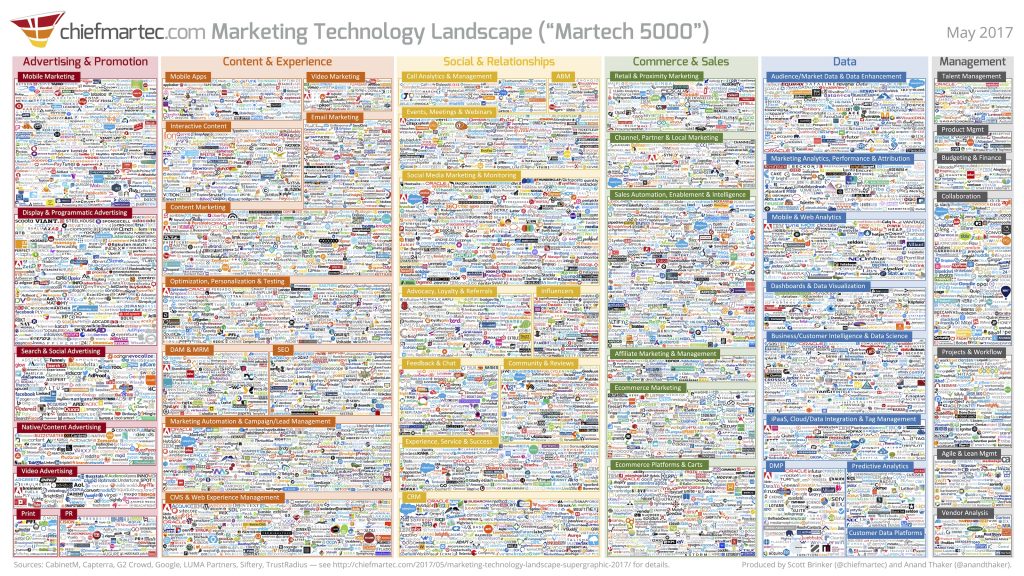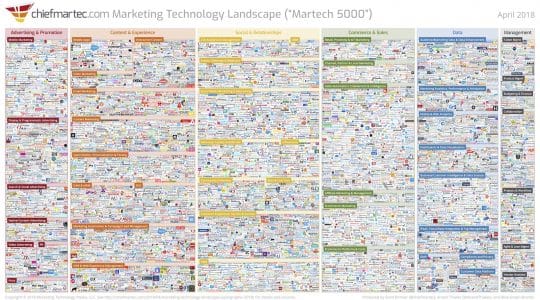
Brands and enterprises know all about marketing tech stacks. Marketing technologist Scott Brinker has assembled 5,381 logos into the current Martech landscape, and there’s even an award — the Stackies — for the best-dressed, best-looking, or most popular martech stack.
But what about mobile-first and mobile-only companies?
If you’re mobile-first, you probably don’t need huge chunks of the literally dozens of categories of martech. Channel marketing? Nope. Sales automation? No sales force to automate. E-commerce platforms? Maybe … but maybe Apple and Google handle all your payment processing. CRM? Not traditional CRM, that’s for sure. Print advertising? Uh-uh. Call analytics? Not in a million years.
But mobile-first and mobile-only companies do have very specific and utterly business-critical marketing technology needs from companies like — shameless plug — TUNE.
I asked Rovio’s former user acquisition manager, currently consultant and entrepreneur, and distinguished industry expert Eric Seufert for his take on what martech needs mobile-first companies have.
John Koetsier: We see a lot about marketing tech stacks for fairly traditional businesses. How do you see them differing for mobile-only companies?

Eric Seufert
Eric Seufert: This is a pretty big question — if by “traditional businesses” you mean big box retailers like Target or big conglomerates like GE, then I have no idea; I don’t think I’ve ever worked for a traditional business.
But if by “traditional business” you mean consumer technology companies that operate websites, like eBay or the big eCommerce retailers, or desktop apps, then there are a few fundamental, structural differences between the mobile app ecosystem and the desktop web ecosystem that impact marketing on mobile.
The first is the install: this simply doesn’t exist on the desktop web, and it creates a lot of complexity around attributing customers and revenue to marketing campaigns. It also means that the most direct path to acquiring a customer on mobile is direct response: no other form of advertising accommodates the click -> install process. TV, out of home, etc. require the user to open the app store and search for the app’s name, which adds an incredible amount of friction to the install process (which isn’t to say that those methods can’t be viable, only that they’re not as efficient as direct response ads).
The second is the impact that the platforms themselves have on distribution through featuring and the charts. This kind of editorial curation doesn’t really exist on the desktop web or with desktop apps. Also, I think it’s empirically true that ASO doesn’t appreciably exist on mobile (I wrote a blog post about this here). In other words, there is no way to drive a significant, business-sustaining amount of traffic to an app through keyword optimization. So SEO, which sort of democratizes website discovery on the web, doesn’t exist on mobile, which puts extra emphasis on the importance of advertising, especially direct response.
These two structural differences create the need for sophisticated marketing technologies that can capture data from multiple components, bring it together in one place, and allow analysts and campaign managers to use it to optimize their marketing spend.
John Koetsier: What are the essential functions of a mobile-only marketing tech stack?
Eric Seufert: At a high level, I’d say the essential function is to harmonize disparate sets of data into profit-oriented metrics that allow mobile marketers to do their jobs decisively and on a short update cycle.
Breaking this down, there are a few essential elements to the type of system that allows for this. I mapped out the mobile user acquisition stack and its component parts here and so I won’t reproduce that. But the mobile user acquisition stack does most of the heavy lifting on direct response marketing and includes things like ad spend aggregation, attribution, campaign optimization tools, etc.
The other piece — and I think a lot of companies ignore this, to their detriment — is the analysis framework that helps marketing teams take a macro view of their spend. What I mean by that is: tracking the profitability of individual installs is important, but having a bigger view of how non-direct response marketing spend impacts revenue, or how organic install volumes change when paid acquisition spend changes, or even how things like weather systems, national holidays, etc. impact profitability.
Understanding the dynamics between these types of forces is probably more important than being able to track the profitability of installs that were generated by direct install campaigns. These types of marketing models aren’t so much dependent on infrastructure as they are the ability of the marketing team to build statistically reliable links between marketing spend and topline revenue, and so the position in a “stack” of this kind of modeling isn’t rigid: it could be done in Excel, or in a Python script, or in a dashboard, or really wherever it’s most easily accessed and digested by the team.
John Koetsier: What’s the point and/or points of connection between them? Do you see a hub-spoke model, or a linear model, a layered model?
Eric Seufert: It’s hierarchical in the way that the dependency chain has some elements being more fundamental than others; for example, data warehousing is more foundational than a dashboard, so it makes sense to represent those two elements with a pyramid shape.
But the modeling concept really exists separately from the stack: it’s very operational. And I think as companies are getting more sophisticated with how they think about marketing and the model that drives their spend, they’re creating hub-and-spoke systems that have user data and install data sitting at the center, with different marketing formats — direct response, TV, out of home, etc. — “plugging into” that central datastore. That’s really what business intelligence is: it presents a snapshot of the product’s state and then attempts to build a fluid model between variables that can recreate that state and predict other states. In other words, it answers the question, “What activities produced the revenue I made today, and I how can I use them to increase the revenue I’ll make tomorrow?”
John Koetsier: I happen to think a central spot is people … a technology where you understand a) who your customers/users are, b) what they do/where you’ve touched them and where they’ve interacted with you, your product, or your tool, c) what they might want in the future, and d) how they’re connected to other people who might be current or future customers/users … perhaps more. Makes sense? Agree? Disagree?
Eric Seufert: Sure, I agree with that, but I’d argue that most of those questions can be answered passively and indirectly with data. So rather than asking, “Who are my customers?” I’d rather just experiment with the various levers I have at my disposal until I make a profit.
I don’t think I need to be able to answer that question with a discrete profile, like “My customers are 28-37 year old middle-class women;” I can iterate my way into figuring that out through experimentation and then fund campaigns that produce profit and kill the ones that don’t. If I’m reaching my target demographic through experimenting with a lot of different things until I find one that works, I don’t necessarily need to know exactly why what I’m doing is working.
John Koetsier: What connective tissue are we currently missing?
Eric Seufert: The analytics and machine learning infrastructure that builds explanatory variables that describe the forces that produce installs.
Again, a lot of developers operate with a bottoms-up marketing mandate: every user is accounted for exclusively through direct response marketing. There’s no problem with that approach, but the success of that approach is limited by the depths of the developer’s wallet: the direct response market is by far the most competitive. Obviously product is a determining factor, but ceteris paribus [translation: all other things being equal], if two products are roughly equivalent but one developer has ten times as much marketing budget as the other, the richer one will win in a purely direct response marketing contest. There are something like 700 apps released to the App Store every day, and there are only so many ways to match pieces of candy or build cities.
This reality has smacked a lot of developers in the face: lots of developers are producing top-notch, impressive products, but very few are breaking through the market’s noise and building user base traction by marketing exclusively through direct response.
The connective tissue I referred to is the set of products and services that help developers diversify their traffic sources beyond just what can be attributed with a discrete tracking link. I built Agamemnon to help developers do this.
John Koetsier: If the future of mobile marketing is quants and high-frequency trading, where’s the art? the creativity? the design? the je-ne-sais-quoi?
Eric Seufert: I think art and creativity extend beyond just drawing pictures and coming up with aesthetic themes and tones for marketing assets. Building a sophisticated predictive model feels a lot like creating art, although there’s no aesthetic element to it. So I don’t see mobile marketing as looking like a creatively-desiccated, purely mechanical function even as it becomes more automated and programmatic.
That said, I think if someone on my team told me they were spending money on a campaign because of the channel’s je-ne-sais-quoi, that conversation would transition into a performance review.
John Koetsier: Thanks for your time and insight!
Author
Before acting as a mobile economist for TUNE, John built the VB Insight research team at VentureBeat and managed teams creating software for partners like Intel and Disney. In addition, he led technical teams, built social sites and mobile apps, and consulted on mobile, social, and IoT. In 2014, he was named to Folio's top 100 of the media industry's "most innovative entrepreneurs and market shaker-uppers." John lives in British Columbia, Canada with his family, where he coaches baseball and hockey, though not at the same time.




[…] Get the entire interview on TUNE’s blog … […]
[…] Mobile martech: Building the mobile-first marketing tech stack, http://www.tune.com […]
[…] Mobile martech: Building the mobile-first marketing tech stack, http://www.tune.com […]
[…] Mobile martech: Building the mobile-first marketing tech stack, http://www.tune.com […]